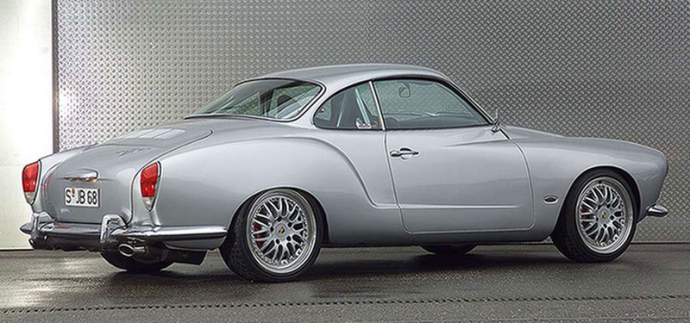My interest in cars is generally directly proportional to how much spare cash I have available. Typically not very much, so for the most part, cars are not something that occupy too much of my thoughts. A few years back though, a small insurance payout presented me with a modest lump sum and I blew it on a 1967 Karmann Ghia (not the one above, sadly). It was the first time I acknowledged and indulged my love of retro styling with a significant purchase – hardly unknown as a vehicle, but still rare enough that it was a bit of a head-turner.
It was developed by coach builders Karmann and the Italian styling house Ghia as a top-of-range sporty companion to the Beetle; designed on a widened Beetle chassis, and with many common components. Allegedly VW knew nothing of the project’s existence until the first prototype was shown to them. Its success was down to a combination of the styling, and the rock-solid reliability of the Beetle’s workmanship. Consequently thousands of them crossed the Atlantic and that’s where the best examples are still found now. Being part of the air-cooled VW family with the Beetle and Combi Van also instilled an element of counter-culture cool. In keeping with those vehicles, many Karmann Ghias are customised, lowered, souped-up or otherwise personalised in a way that has become associated with Californian surf culture. Or then again, Agent 86 driving a convertible in the credit sequence to Get Smart (below).
As much as I loved it though, I found quickly that I’d been softened up by modern cars. The solid, steel bodywork made it very heavy; no power steering here. The heating depended on getting a certain speed up, which for those of you who drive in London will know, doesn’t happen too often. So in the perpetual wet, cold British Autumn and Winter, seeing out of the front often depended on winding the window down (manually) and wiping the inside of the windscreen with a cloth. Being a left-hand drive made for an awkward time with the ticket machines entering and exiting car parks, and if I’m truly honest, I never really got used to the noise of the air-cooled engine.
These are minor points though, in the face of the fact that this was a forty-ish year old car, that never once broke down, and looked great the entire time I owned it. I’d imagine myself driving in the San Francisco of Bullitt, or the LA of Robert Altman & Elliott Gould’s version of The Long Goodbye. Whereas some people choose their cars based on social standing, or practicality, or power, my choice was entirely about how it evoked a particular time and place. Ironically, I’ve never been to California and I was way too young to appreciate the era first-hand, so that in itself has something to say about how we’re guided by our responses to certain media. I’m sure that Volkswagen never envisaged the way the perception of this group of vehicles would evolve over time – that they would be inextricably linked with hippies and surfers thousands of miles from where they were built – but that shows how external factors can have a huge effect on how brands are seen.
Ultimately it being a selfish purchase was what led to it passing into other hands. It was barely a 2+2, and there came a point when something more practical was needed to deal with family life, and it eventually had to go. Unlike any other car I’ve owned though, the Karmann Ghia is the one I still hanker after, especially when seeing Uma Thurman driving one in her piece-to-camera sequences in Kill Bill. After various evolutionary changes, the Karmann Ghia was eventually phased out in 1974 and replaced by the Scirocco. With the success of VW’s modern Beetle, and the popularity of the revived Minis, there was always a nagging hope that just maybe a 21st Century update of the Karmann Ghia was a possibility. If that ever happened I’d be at the front of the queue.







